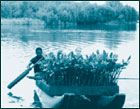
Many small coastal communities depend for their livelihoods on the products of mangrove forests. But often, because of a lack of clearly defined property rights to the resources of the forests, local inhabitants fall victim to exploitation. Timber, shrimp farms, resorts, residences, and mining can all degrade the environment, and once the resources are diminished or depleted, contribute to the loss of livelihood for local people.
The end result has been a dramatic loss of mangrove forests. As much as half the world’s mangroves have been destroyed in the past 50 years, and declining fisheries have been linked to this destruction.
Environmental activists have slowed the exploitation of these forests by convincing governments to set aside vast tracts of coastal areas as protected regions. Unfortunately, local governments and nongovernmental organizations often lack the financial resources to enforce protection, and many regions continue to experience illegal timber harvests and other unsustainable uses.
Nor have these well-intentioned governmental efforts achieved sustainable use of mangrove resources for local inhabitants. Government-owned lands with open access tend toward overuse, and resources are sometimes allocated on the basis of political favors.
An alternative is management of the mangroves by the fishers and farmers who have traditionally inhabited the mangrove forests. Although they may not have legal deed to these lands, they have practiced sustainable use for many years. Establishing ownership rights among mangrove forests is the first step toward poverty reduction among coastal communities.
One community group that has been highly successful in combating the destruction of mangrove forests is the Small Fishers Federation of Sri Lanka (SFFL). The SFFL is funded primarily by investing proceeds from its projects back into the organization, with a few capital-intensive projects funded through grants from international agencies.
This group of individual fishers and small fishing communities banded together in 1984 to fortify themselves against the powerful influence of large corporate and political interests. The SFFL now includes 22 percent of the nation’s independent fishers and more than 146 fishing communities throughout the country.1 The federation helped define clear fishing rights for its members and worked with local and regional enforcement agencies to enforce them.
The SFFL established nurseries to replant degraded forest areas, raised freshwater fingerlings to be sold to inland fishers to restock inland waters, and conducted a host of other environmentally beneficial projects. A tuna processing plant has given added value to local fishers’ catches. The group channels a percentage of its profits into revolving loan programs.
SFFL also supports social welfare. In Southern Sri Lanka, the group opened a small vocational school for disadvantaged youth. Money from business endeavors provides playground equipment and sanitation facilities for several preschools and supports community education centers.
In 2003, the SFFL hosted Sri Lanka’s first environmental tourism group from the United States and Australia since the end of Sri Lanka’s 12-year civil war. During the welcoming ceremonies, Sri Lanka’s Minister of Fisheries commended SFFL for doing “what the Government of Sri Lanka could not; providing environmental education and conservation benefits to the people of Sri Lanka.”
Not every community effort is so successful. In some cases, private property rights are not protected, and corruption can play a role. Consider a small fishing village of some 30 families in the Puttalam district of Sri Lanka. Throughout its history, the families had fished in-and claimed traditional rights to-approximately 40 acres of mangrove forests. In 1996, a developer visited the village and inquired as to who owned the property they fished. Each villager reported that, in fact, no one owned the land, and that it was open to everyone according to traditional rights that allowed locals to harvest from the land. Returning to the capital city of Colombo, the individual claimed legal ownership by filing a few documents with the court.
The village had no legal recourse when the developer returned, cut their forests, and installed private shrimp farms. By their own admission, they didn’t “own” their land. Without the forests, however, local fish populations disappeared, and by January 2003, the shrimp farm’s wastewater had leached salt water into surrounding groundwater, affecting the village’s secondary crop, coconuts. Had there been a history of legal recognition of private property or community rights, this invasion could have been averted, or damages to the villages could have been recovered. Courtesy of Mangrove Action Project
Even if the rights of traditional indigenous people are respected, there is a need for additional income. As healthy mangrove systems are restored, schools of fish begin to flourish, and the fisheries rebound substantially. But fishing alone may not be enough to alleviate poverty in coastal communities.
Other sustainable by-products of mangrove ecosystems can supplement fisheries’ income without reducing fish harvests or depleting mangroves. The following list proposes activities that could provide income from coastal forest resources while promoting the protection of those resources.
- Bamboo. A 60-hectare bamboo plantation can produce the equivalent of 500 hectares of trees for use as building material (Environmental Bamboo Foundation 2002, 22). In addition to providing an inexpensive source of high-quality renewable construction material that promotes higher returns than mangrove wood, bamboo can lower the demand for mangrove wood for construction.
- Coconut husks. Coconut plantations provide numerous products such as coconut meat and milk, but coconut husks have traditionally been waste products. A simple process of converting husks to charcoal can make the husks marketable. Coconut charcoal can be used for cooking, heating, and as the heating base for smoking meat and fish. When carefully steamed, charcoal can be made into activated charcoal for use in water purifiers. This use of coconut husks will reduce the demand on mangrove wood for charcoal.
- Fish smokehouses. Well-designed fish smokehouses could replace current fish preservation by sun drying and open pit fires, a slow and relatively unsanitary system. Smokehouses would lower spoilage, increase efficiency, and reduce dependence on mangrove wood for fuel.
- Surimi paste. Made from a variety of white fish, surimi is used around the world. It is known to consumers in the United States in the form of artificial crabmeat. Surimi processing lengthens the shelf life of fish and increases the value of smaller fish. It would give local people another incentive to protect the mangrove ecosystem that nurtures numerous small fish.
- Small-scale aquaculture. Tilapia (a carp-like fish) can be raised in small ponds at minimal cost. Tilapia benefits the pond ecosystem by removing algae and oxygen-depleting plants. Larger tilapia can be sold for filets, while smaller fish can be processed as surimi. Raising tilapia can reduce the demand for other fish in the mangrove forest area. Because tilapia can be harvested year-round, it can provide a food source while wild fish are breeding.
- Small-scale ecotourism. Recent years have seen a growing affluent population that travels internationally to observe or protect rare or endangered ecosystems. Ecotourism can take the form of bird watching, fly fishing, scuba diving, or biodiversity awareness tours. Mangrove forests would benefit because the protected areas increase in value as biodiversity increases.
In summary, the future of environmental sustainability lies in the ability of private enterprise to regulate the consumption of resources through the incentives provided by private property rights. When it comes to mangrove forests, those property rights should be held by local people-those who have traditional rights to the mangrove resources.
NOTE
1. Anuradha Wickramasinghe, director, Small Fishers Federation, personal correspondence, January 2003.
REFERENCES
Environmental Bamboo Foundation. 2002. How to Preserve Bamboo-Vertical Soak Diffusion Method. Bali, Indonesia: Environmental Bamboo Foundation.
Samuel S. Nugent is administrative director of the Mangrove Action Project, a nonprofit organization based in Port Angeles, Washington, dedicated to the conservation of mangrove forest areas. Nugent was a 2003 fellow at the Kinship Conservation Institute conducted by PERC.



